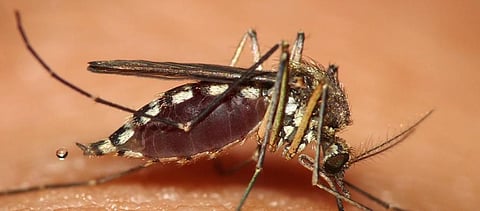

Uttar Pradesh, which has been successful in keeping Acute Encephalitis Syndrome in check this year, saw a worrying trend when it came to Japanese Encephalitis (JE). The state saw a larger share of JE cases in the total AES figure, said officials.
JE, which is a mosquito-borne viral infection of the brain, was said to be in check till last year owing to mass vaccination programmes and awareness drives. Also, the water-borne enterovirus encephalitis, which is caused by virus found in pigs and birds, used to be the highest reported kind of encephalitis.
While every year JE cases used to be 4-7 per cent of the total AES cases, this time they have risen to 25 per cent, which is more than a threefold increase, said an official from Baba Raghav Das (BRD) Medical College in Gorakhpur that sees patients from various districts of eastern Uttar Pradesh and neighbouring Nepal and Bihar. The official, who did not wish to be named, did not give an exact figure.
Chief Minister Yogi Adityanath was also told about this increase during a visit to the hospital on June 22, 2019. However, the officials had not mentioned any specific number even then.
What caused this?
Doctors and experts are unsure what could have caused this.
"The share of JE cases have increased this year," confirmed SK Tiwari, chief medical officer, District Hospital, Gorakhpur. “It could be due to two reasons. One, the sampling and testing facility has been strengthened. The National Institute of Virology, Pune is checking each sample so the diagnosis has increased. Two, cases of JE are mostly coming from areas with poor sanitation practices and where children are undernourished. We have asked ICDS (Integrated Child Development Services) to pay special attention to this,” added Tiwari.
The district hospital, which maintains data only for Gorakhpur division, has recorded six encephalitis deaths between January 1 and June 28, 2019. Of these, one death was due to JE.
Inadequate vaccination dose during the mass JE vaccination programme in 2006 and 2010 is one of the main reasons for the rise in JE cases, said RN Singh, private paediatrician, who was earlier with BRD Medical College.
According to World Health Organization guidelines, two primary doses are administered to prevent JE. But, only one dosage was given to one year olds, said Singh, who is also a campaigner for eradication of encephalitis.
“Two doses — one when the child is nine months old and the other at 16 months — were only started in 2012-13 in the government’s National Immunisation Programme (NIP). So, many children were left out. Those who were not a year old in 2010 became overage and so they neither got vaccine in the mass drive nor under NIP. These left out children could be the ones contracting JE now,” he said.
Overall decline
The overall AES figures, however, have come down since 2017, when more than 62 children died in August due to encephalitis at BRD Medical College. Of them, 31 died in just two days due to lack of oxygen cylinders at the hospital.
Since then, the state administration has claimed that the district has seen a sharp fall in AES and JE cases. In the last two years, the deaths due to AES in Uttar Pradesh dropped to 230 in 2018 from 654 in 2017. The number of AES cases reported also dropped to 3,080 in 2018 from 4,724 in 2017, according to Directorate of National Vector Borne Disease Control Programme, Delhi.
So far, the hospital has recorded 16 deaths and 440 AES cases. It is still a cause of worry, as the season for the disease has not yet started in full force. The cases for AES, which subsumes JE and water borne enterovirus encephalitis, mostly shoot up during monsoon.
Besides poor sanitation, other reasons for the cases could be inadequate fogging, anti-mosquito measures and failure of the administration in keeping pigs away from human habitats. JE is caused due to mosquitoes and pigs, with pigs acting as an amplifying host after a male mosquito bites it.
“There was a drive launched to segregate pigs from human habitation but it has not been done successfully, but it would be wrong to say that nothing has been done,” said Rajesh Mani, an activist with non-profit Manav Seva Sansthan and the chief petitioner in the high court on the issue.
“Dastak, an awareness campaign, was launched in February 2018. It focused on training doctors, nurses, malaria officers, auxiliary nurse midwives and teachers and included a door-to-door campaign,” added Mani.
A fresh Dastak campaign was launched on July 1 in 18 districts in eastern Uttar Pradesh. However, after the deaths within a week in 2017, release of data has been hampered by the Gorakhpur hospital and health authorities, said the activist.
“Earlier a health bulletin used to be issued by the BRD hospital but they have stopped doing it since 2017. The cases and deaths have reduced in the last two years but we cannot completely know what the exact situation is,” he said.